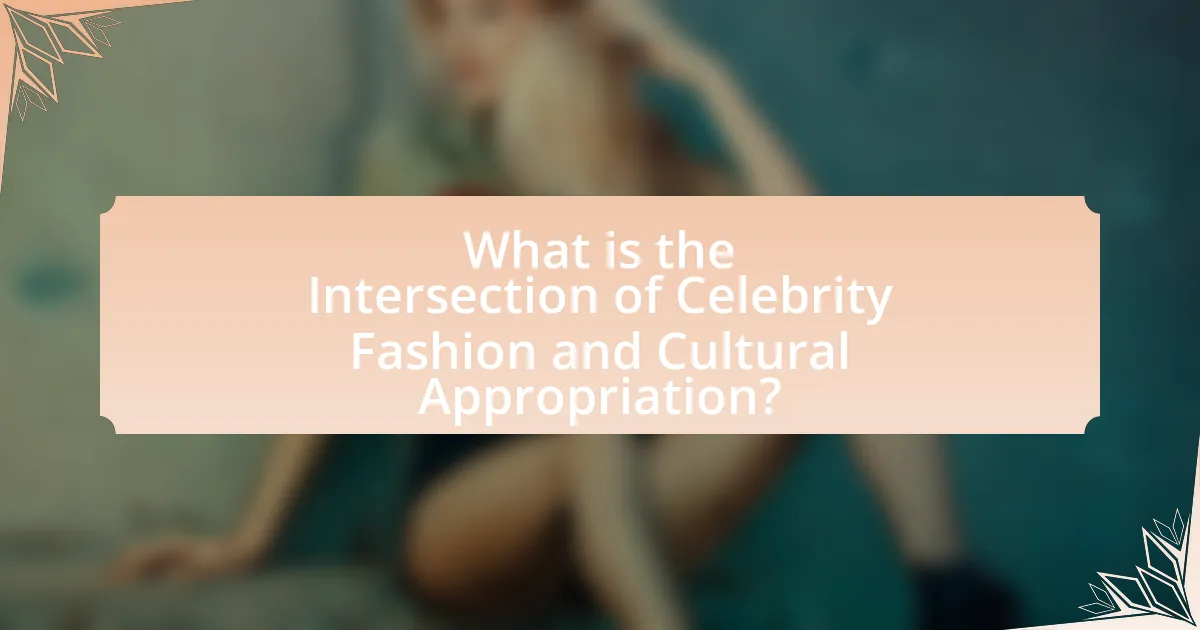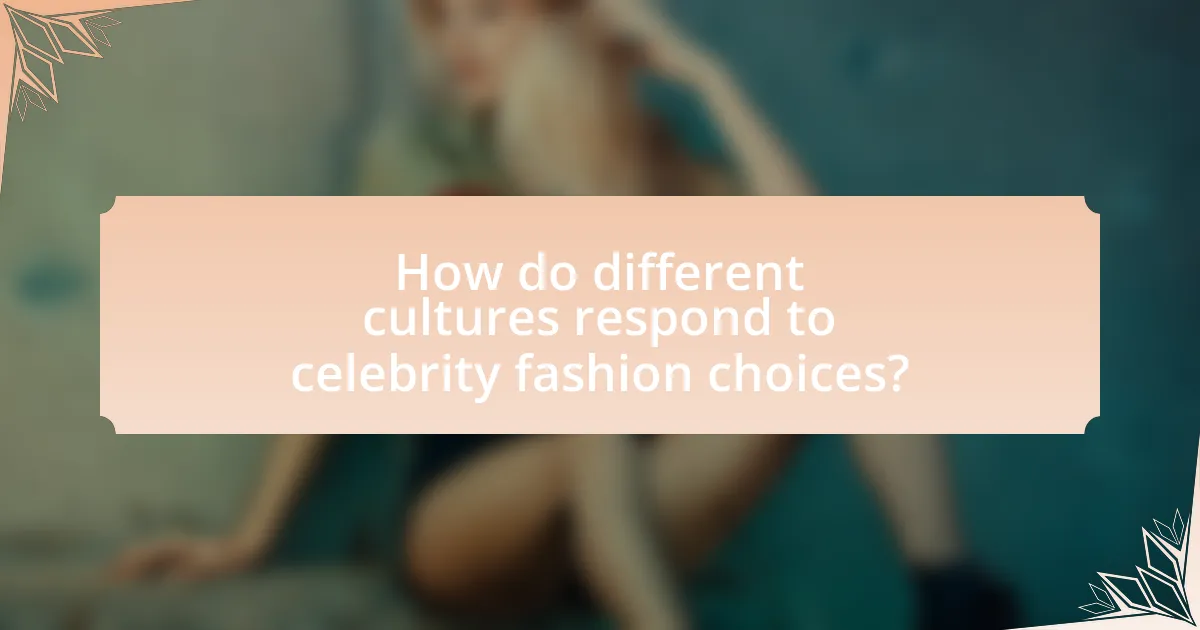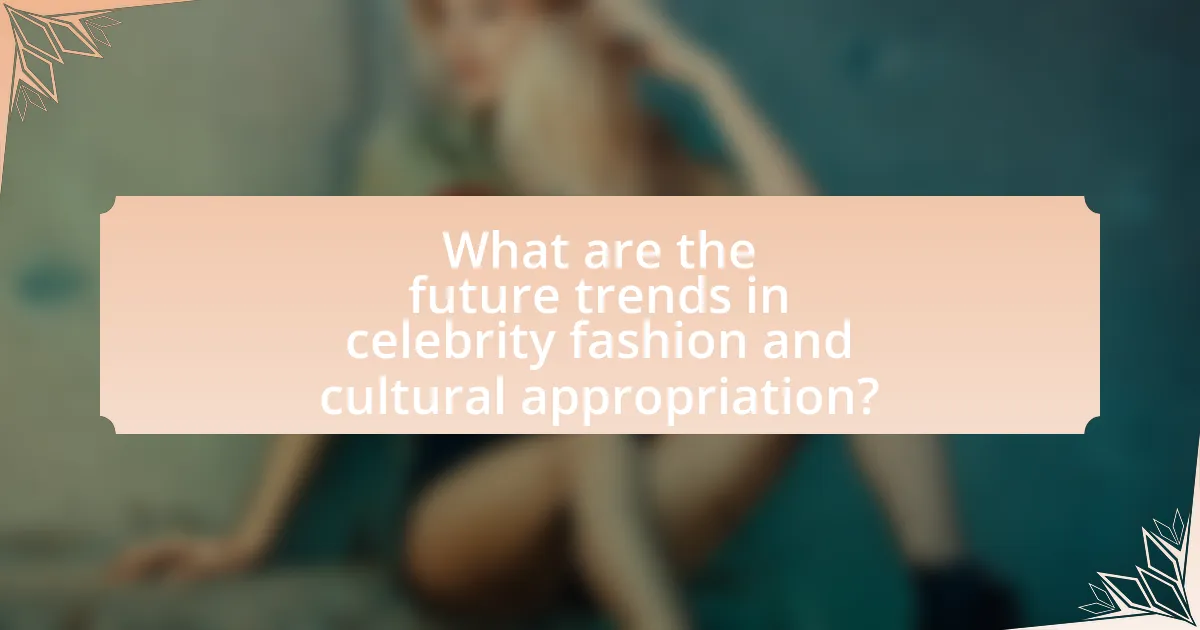The article examines the intersection of celebrity fashion and cultural appropriation, highlighting how celebrities often adopt elements from marginalized cultures without understanding their significance. It discusses the impact of celebrity fashion choices on public perception, the distinction between cultural appropriation and appreciation, and the role of social media in shaping these conversations. The article also explores the responses of various cultural groups to celebrity fashion, the implications for the fashion industry, and strategies for promoting cultural sensitivity. Additionally, it emphasizes the importance of collaboration with cultural representatives and the evolving trends towards inclusivity and ethical practices in fashion.

What is the Intersection of Celebrity Fashion and Cultural Appropriation?
The intersection of celebrity fashion and cultural appropriation occurs when celebrities adopt elements from marginalized cultures in their fashion choices, often without understanding or respecting the cultural significance behind those elements. This practice can lead to the commodification of cultural symbols, as seen in instances where celebrities wear traditional garments or hairstyles from cultures that are not their own, such as the use of Native American headdresses or African hairstyles. The backlash against such actions highlights the importance of cultural sensitivity and the need for celebrities to acknowledge the origins and meanings of the fashion they choose to represent.
How do celebrity fashion choices reflect cultural influences?
Celebrity fashion choices reflect cultural influences by showcasing trends, styles, and symbols that resonate with specific cultural narratives. For instance, when celebrities adopt traditional garments or motifs from various cultures, they often bring attention to those cultures, sometimes leading to appreciation or, conversely, appropriation. A notable example is the use of Native American headdresses in fashion shows, which sparked debates about cultural sensitivity and respect. This illustrates how celebrity fashion can both celebrate and misrepresent cultural identities, highlighting the complex relationship between fame and cultural representation.
What are some examples of celebrities who have embraced cultural styles?
Celebrities who have embraced cultural styles include Rihanna, who often incorporates traditional African prints and motifs into her fashion choices, and Selena Gomez, who has been seen wearing Mexican-inspired designs that celebrate her heritage. Additionally, Pharrell Williams frequently showcases Asian influences in his clothing, while Beyoncé has highlighted African culture through her visual aesthetics and performances. These examples illustrate how celebrities can celebrate and honor cultural styles through their fashion, contributing to a broader dialogue about cultural appreciation versus appropriation.
How do these choices impact public perception of cultural fashion?
Choices made by celebrities in cultural fashion significantly shape public perception by either promoting appreciation or fostering appropriation. When celebrities adopt elements from diverse cultures respectfully and authentically, it can lead to increased awareness and appreciation of those cultures, as seen with figures like Rihanna, who has incorporated traditional garments into mainstream fashion while acknowledging their origins. Conversely, when celebrities use cultural symbols without understanding or respect, it can perpetuate stereotypes and lead to accusations of cultural appropriation, negatively impacting public perception and causing backlash, as evidenced by controversies surrounding outfits worn by stars like Katy Perry and Kim Kardashian. These dynamics illustrate how celebrity choices can either bridge cultural gaps or widen them, influencing societal attitudes toward cultural fashion.
Why is cultural appropriation a significant issue in fashion?
Cultural appropriation is a significant issue in fashion because it involves the unauthorized use of elements from one culture by members of another, often leading to exploitation and misrepresentation. This practice can perpetuate stereotypes and diminish the cultural significance of traditional attire, as seen when high-profile designers adopt indigenous patterns or garments without acknowledgment or respect for their origins. For instance, the 2015 backlash against a major fashion brand for using Native American headdresses in a runway show highlighted how such actions can offend and alienate the communities from which these cultural symbols originate.
What defines cultural appropriation in the context of fashion?
Cultural appropriation in the context of fashion is defined as the adoption of elements from one culture by members of another culture, particularly when the dominant culture appropriates from marginalized or minority cultures without permission or understanding. This practice often leads to the commodification of cultural symbols, which can strip them of their original meaning and significance. For example, when high-fashion brands incorporate traditional garments or motifs from Indigenous cultures into their collections without acknowledging their origins or the cultural significance, it exemplifies cultural appropriation. This phenomenon has sparked significant debate and criticism, particularly regarding issues of power dynamics, exploitation, and respect for cultural heritage.
How does cultural appropriation differ from cultural appreciation?
Cultural appropriation differs from cultural appreciation in that appropriation involves taking elements from a culture, often without permission or understanding, and using them in a way that can exploit or disrespect the original culture. In contrast, cultural appreciation involves a respectful acknowledgment and understanding of another culture, often engaging with it in a way that honors its significance and context. For example, wearing traditional attire from another culture in a respectful manner, such as during cultural festivals with permission from the community, exemplifies appreciation, while wearing such attire as a costume for entertainment without context exemplifies appropriation.
What role do social media and public opinion play in celebrity fashion?
Social media and public opinion significantly influence celebrity fashion by shaping trends and driving consumer behavior. Platforms like Instagram and TikTok allow celebrities to showcase their styles directly to millions, creating immediate feedback loops where public opinion can elevate or diminish a fashion choice. For instance, a study by the Pew Research Center found that 72% of teenagers use Instagram, making it a powerful tool for celebrities to set trends that resonate with younger audiences. Additionally, public opinion can lead to rapid changes in fashion acceptance, as seen when celebrities face backlash for cultural appropriation, prompting them to reconsider their fashion choices. This dynamic interaction between social media visibility and public sentiment ultimately dictates what is deemed fashionable in the celebrity sphere.
How has social media changed the conversation around cultural appropriation?
Social media has significantly amplified the conversation around cultural appropriation by providing a platform for marginalized voices to express their concerns and perspectives. This shift has led to increased awareness and scrutiny of cultural practices, particularly in celebrity fashion, where appropriation often occurs. For instance, viral social media campaigns and hashtags, such as #CulturalAppropriation, have mobilized public discourse, allowing individuals to share personal experiences and educate others about the implications of borrowing cultural elements without proper context or respect. Research indicates that social media has democratized the conversation, enabling a broader range of participants to engage in discussions that were previously dominated by mainstream narratives.
What are the consequences of public backlash against celebrities for cultural appropriation?
Public backlash against celebrities for cultural appropriation can lead to significant reputational damage and financial repercussions. When celebrities face criticism for appropriating elements from marginalized cultures, they often experience a decline in public support, which can result in lost endorsements and decreased sales of their products. For instance, in 2018, celebrity Kim Kardashian faced backlash for her “Kimono” shapewear line, leading her to rebrand the product after public outcry. Additionally, such backlash can prompt broader discussions about cultural sensitivity and lead to increased scrutiny of celebrity actions, influencing industry standards and practices regarding cultural representation.

How do different cultures respond to celebrity fashion choices?
Different cultures respond to celebrity fashion choices in varied ways, often influenced by local values, traditions, and social norms. For instance, in Western cultures, celebrity fashion is frequently emulated and celebrated, leading to trends that can rapidly gain popularity, as seen with the influence of figures like Kim Kardashian or Rihanna. Conversely, in cultures with strong traditional attire, such as in many African or Asian societies, celebrity fashion choices may be scrutinized for cultural appropriation, where elements of their heritage are adopted without proper respect or understanding. This scrutiny is evident in instances like when celebrities wear traditional garments, prompting discussions about authenticity and respect for cultural significance. Such responses highlight the complex interplay between admiration and criticism, reflecting broader societal attitudes towards identity and representation in fashion.
What are the perspectives of various cultural groups on appropriation?
Various cultural groups perceive appropriation as a complex issue, often viewing it as a form of exploitation or disrespect. For instance, Indigenous communities frequently express that cultural appropriation dilutes their traditions and commodifies sacred symbols, as seen in the backlash against non-Indigenous individuals wearing traditional headdresses at music festivals. Similarly, African American groups highlight that appropriation often involves the mainstream adoption of cultural elements, such as hairstyles or fashion, without acknowledgment of their origins or the historical context of oppression, exemplified by the controversy surrounding white celebrities adopting styles like cornrows. In contrast, some groups may see cultural exchange as a positive interaction, provided it is done respectfully and with proper acknowledgment. This divergence in perspectives underscores the need for sensitivity and understanding in discussions about cultural appropriation.
How do cultural leaders and influencers react to celebrity fashion?
Cultural leaders and influencers often react to celebrity fashion with a mix of admiration and criticism, particularly when it intersects with issues of cultural appropriation. They may praise celebrities for their ability to bring diverse styles into mainstream fashion, recognizing the potential for increased visibility of various cultures. However, they also frequently highlight concerns regarding the appropriation of cultural symbols without proper acknowledgment or respect for their origins. For instance, instances where celebrities adopt traditional attire or motifs from marginalized cultures can lead to backlash, as cultural leaders emphasize the importance of understanding the historical and social contexts behind these elements. This dual reaction underscores the ongoing dialogue about respect, representation, and the ethical implications of fashion choices in a globalized world.
What are the implications of these reactions for the fashion industry?
The implications of these reactions for the fashion industry include increased scrutiny of cultural appropriation and a demand for greater authenticity and representation. As consumers become more aware of the cultural significance of fashion choices, brands face pressure to ensure that their designs respect and honor the cultures they draw inspiration from. This shift is evidenced by the backlash against celebrities and brands that have faced criticism for appropriating cultural symbols without proper acknowledgment or understanding, leading to potential boycotts and loss of consumer trust. Consequently, the fashion industry must adapt by prioritizing inclusivity, collaborating with diverse designers, and fostering genuine cultural exchange to maintain relevance and consumer loyalty.
How can celebrities navigate cultural sensitivity in fashion?
Celebrities can navigate cultural sensitivity in fashion by actively engaging with and respecting the cultures they draw inspiration from. This involves thorough research into the cultural significance of garments and symbols, consulting with cultural representatives, and prioritizing collaborations with designers from those cultures. For instance, when celebrities wear traditional attire, they should understand its historical context and meaning, as seen in instances where cultural misappropriation sparked backlash, such as the criticism faced by celebrities for wearing Native American headdresses without understanding their significance. By fostering genuine dialogue and understanding, celebrities can promote appreciation rather than appropriation, thereby contributing positively to cultural representation in fashion.
What strategies can celebrities use to avoid cultural appropriation?
Celebrities can avoid cultural appropriation by engaging in thorough research and understanding the cultural significance of the elements they wish to incorporate into their fashion. This involves consulting with cultural experts and members of the communities from which these elements originate, ensuring that their use is respectful and informed. For instance, when adopting traditional attire or symbols, celebrities should recognize their historical context and the potential implications of their usage. Additionally, collaborating with designers from the culture being represented can provide authenticity and respect, as seen in instances where fashion lines have been co-created with cultural representatives. By prioritizing education, collaboration, and respect for cultural heritage, celebrities can navigate the complexities of cultural appropriation effectively.
How can collaboration with cultural representatives enhance authenticity?
Collaboration with cultural representatives enhances authenticity by ensuring that cultural elements are accurately represented and respected. When fashion brands partner with individuals who have deep knowledge and connection to a culture, they gain insights that prevent misrepresentation and appropriation. For instance, brands like Gucci and Dior have engaged with cultural consultants to create collections that honor the traditions and aesthetics of specific cultures, leading to a more genuine portrayal. This approach not only fosters respect but also builds trust with the cultural community, as seen in the positive reception of collections that reflect authentic cultural narratives rather than stereotypes.

What are the future trends in celebrity fashion and cultural appropriation?
Future trends in celebrity fashion will increasingly emphasize inclusivity and cultural sensitivity, reflecting a growing awareness of cultural appropriation. As celebrities become more conscious of the implications of their fashion choices, there will be a shift towards collaborations with designers from diverse backgrounds, ensuring authentic representation. For instance, the rise of social media has amplified voices advocating for cultural respect, leading to backlash against celebrities who appropriate cultural symbols without understanding their significance. This trend is supported by data showing that 62% of consumers prefer brands that demonstrate cultural awareness and respect. Consequently, the future of celebrity fashion will likely prioritize ethical practices and cultural appreciation over appropriation.
How is the fashion industry evolving in response to cultural appropriation debates?
The fashion industry is evolving by increasingly prioritizing inclusivity and cultural sensitivity in response to cultural appropriation debates. Designers and brands are now more frequently collaborating with cultural representatives and incorporating authentic cultural elements in a respectful manner, rather than appropriating them without acknowledgment. For instance, brands like Gucci and Dior have faced backlash for cultural insensitivity and have since made efforts to hire diverse teams and consult with cultural experts to ensure that their collections honor the cultures they draw inspiration from. This shift reflects a growing recognition of the importance of ethical practices in fashion, as evidenced by the rise of initiatives like the Fashion Pact, which emphasizes sustainability and respect for cultural heritage.
What changes are being made by brands to promote inclusivity?
Brands are implementing diverse representation in marketing campaigns to promote inclusivity. This includes featuring models of various ethnicities, body types, and abilities, which reflects a broader spectrum of society. For instance, major fashion brands like Savage X Fenty and Aerie have gained recognition for their commitment to inclusivity by showcasing a wide range of sizes and backgrounds in their advertisements. Additionally, brands are increasingly collaborating with designers from underrepresented communities, ensuring that diverse voices are heard and represented in the fashion industry. This shift not only enhances brand image but also aligns with consumer demand for authenticity and social responsibility, as evidenced by studies showing that 67% of consumers prefer brands that demonstrate inclusivity.
How are emerging designers addressing cultural representation in their work?
Emerging designers are addressing cultural representation in their work by actively incorporating elements from their own cultural backgrounds and collaborating with communities to ensure authenticity. This approach not only honors their heritage but also challenges the mainstream fashion narrative that often appropriates cultural symbols without understanding their significance. For instance, designers like Pyer Moss and Telfar Clemens have gained recognition for their commitment to showcasing Black culture and history through their collections, which often include storytelling elements that resonate with their communities. This practice is supported by a growing consumer demand for transparency and ethical representation in fashion, as evidenced by surveys indicating that 67% of consumers prefer brands that demonstrate cultural sensitivity.
What can consumers do to support ethical fashion choices?
Consumers can support ethical fashion choices by prioritizing brands that adhere to sustainable and fair labor practices. This includes researching companies to ensure they use eco-friendly materials, pay fair wages, and maintain safe working conditions. For instance, a 2021 report by the Fashion Transparency Index found that only 40% of brands disclose their supply chain practices, highlighting the importance of consumer awareness in driving change. By choosing to purchase from transparent brands, consumers can influence the fashion industry towards more ethical practices.
How can consumers educate themselves about cultural appropriation in fashion?
Consumers can educate themselves about cultural appropriation in fashion by actively researching the cultural significance of clothing and accessories before purchasing or wearing them. This involves understanding the historical context and meanings behind specific garments, which can often be found in academic articles, books, and documentaries that explore the relationship between fashion and culture. For example, the book “Cultural Appropriation and the Arts” by James O. Young provides insights into how cultural elements are often misrepresented or commodified in fashion. Additionally, following discussions on social media platforms and engaging with voices from marginalized communities can provide real-time perspectives on cultural appropriation issues.
What are some best practices for promoting cultural respect in fashion consumption?
Best practices for promoting cultural respect in fashion consumption include prioritizing ethical sourcing, engaging with cultural communities, and educating consumers about cultural significance. Ethical sourcing ensures that fashion brands collaborate with artisans and communities, providing fair compensation and respecting traditional practices. Engaging with cultural communities allows designers to gain insights and permission to use cultural elements, fostering mutual respect. Educating consumers about the history and significance of cultural attire helps prevent appropriation and encourages appreciation. For instance, brands like Stella McCartney emphasize sustainable practices and cultural collaboration, demonstrating a commitment to respect and authenticity in fashion.